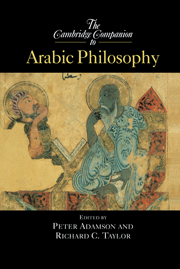Book contents
- Frontmatter
- 1 Introduction
- 2 Greek into Arabic
- 3 Al-Kindī and the reception of Greek philosophy
- 4 Al-Fāarābī and the philosophical curriculum
- 5 The Ismāīlīs
- 6 Avicenna and the Avicennian Tradition
- 7 Al-Ghazālī
- 8 Philosophy in Andalusia
- 9 Averroes
- 10 Suhrawardī and Illuminationism
- 11 Mysticism and philosophy
- 12 Logic
- 13 Ethical and political philosophy
- 14 Natural philosophy
- 15 Psychology
- 16 Metaphysics
- 17 Islamic philosophy and Jewish philosophy
- 18 Arabic into Latin
- 19 Recent trends in Arabic and Persian philosophy
- Select bibliography and further reading
- Index
19 - Recent trends in Arabic and Persian philosophy
Published online by Cambridge University Press: 28 May 2006
- Frontmatter
- 1 Introduction
- 2 Greek into Arabic
- 3 Al-Kindī and the reception of Greek philosophy
- 4 Al-Fāarābī and the philosophical curriculum
- 5 The Ismāīlīs
- 6 Avicenna and the Avicennian Tradition
- 7 Al-Ghazālī
- 8 Philosophy in Andalusia
- 9 Averroes
- 10 Suhrawardī and Illuminationism
- 11 Mysticism and philosophy
- 12 Logic
- 13 Ethical and political philosophy
- 14 Natural philosophy
- 15 Psychology
- 16 Metaphysics
- 17 Islamic philosophy and Jewish philosophy
- 18 Arabic into Latin
- 19 Recent trends in Arabic and Persian philosophy
- Select bibliography and further reading
- Index
Summary
In this chapter I will discuss Arabic and Persian philosophical trends as presented in texts mainly from the sixteenth and seventeenth centuries and their more recent continuation. Philosophical activity continued especially in the lands marked by the geopolitical boundaries of Persianate influence, centered in the land of Iran as marked since the Safavid period beginning in 1501. Of the philosophers in the earlier, formative period of Arabic philosophy, it was Avicenna whose works made the most direct and lasting impact on all subsequent philosophical trends and schools. The structure, techniques, and language of Avicenna’s philosophy - best exemplified in his two main works, al-Ishārāt wa al-tanbīhāt and al-Shifā' - define a holistic system against which all subsequent philosophical writings, in both Arabic and Persian, are measured. Avicenna’s philosophical texts give Arabic and Persian Peripatetic philosophy its technical language and methodology, as well as setting out a range of philosophical problems in semantics, logic, ontology, epistemology, and so on. Later trends must be regarded as refinements and developments from within philosophical texts already established by the twelfth century C.E.
- Type
- Chapter
- Information
- The Cambridge Companion to Arabic Philosophy , pp. 405 - 425Publisher: Cambridge University PressPrint publication year: 2004
- 2
- Cited by

